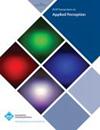Depth Artifacts Caused by Spatial Interlacing in Stereoscopic 3D Displays
IF 2.1
4区 计算机科学
Q3 COMPUTER SCIENCE, SOFTWARE ENGINEERING
引用次数: 8
Abstract
Most spatially interlacing stereoscopic 3D displays display odd and even rows of an image to either the left or the right eye of the viewer. The visual system then fuses the interlaced image into a single percept. This row-based interlacing creates a small vertical disparity between the images; however, interlacing may also induce horizontal disparities, thus generating depth artifacts. Whether people perceive the depth artifacts and, if so, what is the magnitude of the artifacts are unknown. In this study, we hypothesized and tested if people perceive interlaced edges on different depth levels. We tested oblique edge orientations ranging from 2 degrees to 32 degrees and pixel sizes ranging from 16 to 79 arcsec of visual angle in a depth probe experiment. Five participants viewed the visual stimuli through a stereoscope under three viewing conditions: noninterlaced, interlaced, and row averaged (i.e., where even and odd rows are averaged). Our results indicated that people perceive depth artifacts when viewing interlaced stereoscopic images and that these depth artifacts increase with pixel size and decrease with edge orientation angle. A pixel size of 32 arcsec of visual angle still evoked depth percepts, whereas 16 arcsec did not. Row-averaging images effectively eliminated these depth artifacts. These findings have implications for display design, content production, image quality studies, and stereoscopic games and software.立体三维显示中空间交错引起的深度伪影
大多数空间交错立体3D显示器将图像的奇数行和偶数行显示给观看者的左眼或右眼。然后,视觉系统将交错的图像融合成一个单一的感知。这种基于行的交错在图像之间产生了一个小的垂直差;然而,隔行也可能引起水平差异,从而产生深度伪影。人们是否感知到深度人工制品,如果是,人工制品的大小是未知的。在这项研究中,我们假设并测试了人们是否在不同的深度层次上感知到交错的边缘。在深度探测实验中,我们测试了倾斜边缘方向从2度到32度,像素大小从16到79弧秒的视角。五名参与者在三种观看条件下通过立体镜观看视觉刺激:非隔行、隔行和平均行(即偶数行和奇数行平均)。结果表明,人们在观看隔行立体图像时,会感知到深度伪影,并且这些深度伪影随像素大小而增大,随边缘方向角度而减小。当像素大小为32弧秒的视角时,深度感知仍然存在,而16弧秒的视角则没有。行平均图像有效地消除了这些深度伪影。这些发现对显示设计、内容制作、图像质量研究、立体游戏和软件都有启示意义。
本文章由计算机程序翻译,如有差异,请以英文原文为准。
求助全文
约1分钟内获得全文
求助全文
来源期刊

ACM Transactions on Applied Perception
工程技术-计算机:软件工程
CiteScore
3.70
自引率
0.00%
发文量
22
审稿时长
12 months
期刊介绍:
ACM Transactions on Applied Perception (TAP) aims to strengthen the synergy between computer science and psychology/perception by publishing top quality papers that help to unify research in these fields.
The journal publishes inter-disciplinary research of significant and lasting value in any topic area that spans both Computer Science and Perceptual Psychology. All papers must incorporate both perceptual and computer science components.
 求助内容:
求助内容: 应助结果提醒方式:
应助结果提醒方式:


